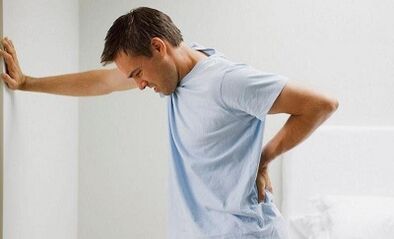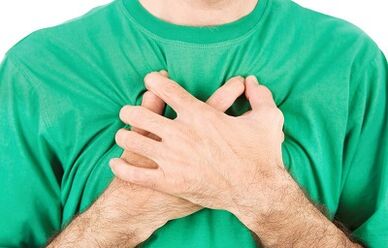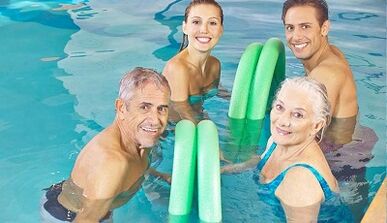
Lumbar osteochondrosis is a chronic damage to the lumbar spine that develops in the intervertebral disc as a result of physical influence and metabolic disorders.It has been proven that lumbar osteochondrosis is the cause of back pain in 75% of cases.
Lumbar spinal defeat occurs in 60% of the population of the planet - this is the most common manifestation of osteochondrosis.The first signs of the disease appear in 20-30 years.
The danger of the disease is that in the final stages of the disease (when the highlights (highlights) and the intervertebral disc hernia occur), complications are developing that require surgical intervention, in particular, plantar fascia and heaps.
Lumbar osteochondrosis often complicates pregnancy.
Causes of lumbar osteochondrosis
The main cause of the disease is the systematic burden of the lumbar spine and the metabolic disorders of the intervertebral disc.Lifting weight, excess weight, continuous physical work increases pressure on the vertebrate column.
Other causes of lumbar osteochondrosis: inactive and sedentary lifestyle, high heels, malnutrition, little use of fluid, smoking, alcohol abuse.
When the protective muscle frame and the absence of treatment, the blood supply to the tissue worsen and the degenerative process in the intervertebral disc is worsening.As a result, the intervertebral disc does not receive sufficient blood supply - they lose elasticity, "dry", inflamed, flattened and prominent.
When standing out (protrusion), the spinal cord is violated, which is characterized by pain at rest and during movement.Improper posture and injury trigger an uneven load on the spinal column, which accelerates the development of lumbar osteochondrosis.
Stage of lumbar osteochondrosis
The specialty of the disease is the development of the degenerative process gradually.
Neurologists distinguish 4 stages of lumbar osteochondrosis:
- Stage 1& mbsp;Partial inflammation and level of intervertebral disc.It is indicated by burning at the bottom and the stupid is not intense pain in the bottom.Unpleasant sensations arise after physical work, lifting weight.
- Stage -2- The distance between the vertebrae is reduced, the changes in the fibrous ring around the tissue are determined on the radiograph, and the disc protection occurs.The patient feels sharp pain in the lower back, which gives (emits) to the back and feet.
- Stage -3- The appearance of intervertebral hernia due to the destruction of vertebral fibrous rings.At the 3rd stage, the cartilage and vertebrae are intensively destroyed.The pain has a continuous character, they are felt even when resting.
- The 4th stage- cartilage and intervertebral disc atrophy, accompanied by the pathology of vertebral bone tissue and the formation of osteophytes.Pain occurs with any movement and uncomfortable body position.The pain doesn't go alone.These violations require intensive treatment and lead to severe human defects.
Symptoms of lumbar osteochondrosis

In seventy percent of cases, doctors diagnose the disease in the second stage.During this time, the patient recorded a frequent period of bright symptoms:
- Low pain, enhanced by physical energy.As the degenerative process develops, the pain becomes severe and fixed;
- Movement restrictions.Movement is accompanied by increased pain with irradiation in the back and feet;
- changes in sensitivity to the lower leg (tingling, burning, numbness);
- spinal muscle tension;
- Numbness and purity of the foot.
Diagnosis of lumbar osteochondrosis
In 85% of cases, doctors make diagnosis using radiography, computed tomography and magnetic-resistance imaging (MRI).
The most intended method is MRI.With his help, the doctor determines the place and level of damage to the lumbar spine.
The main task of the specialist is to distinguish osteochondrosis from Bekhterev's disease.
Complications of lumbar osteochondrosis
Lumbar radiculitis, or casting syndrome: pathological processes in the spinal cord (spine) are the most common complications of lumbar osteochondrosis.It occurs in 55% of cases.It is accompanied by pain and affected sensitivity to the bottom and/or along the root.
In the final stages of the disease, the winding intervertebral disc - Blend on the edge of the vertebra - the protrusion occurs.When the fibrous ring is destroyed, the intervertebral hernia is formed.Intervertebral hernia is an opportunity to contact a neurosurgeon.
In 40% of patients, the sciatic nerves are inflamed.This causes pain, numbness of the limbs.As a result, the patient is weight loss to healthy feet;The spine is more curved, which exacerbates the severity of the disease.

10% of patients develop narrowing of the spinal cord, or compression myelopathy - squeeze the spinal cord.Requires surgical treatment.
The most rare, but dangerous complications are the "horse's tail" syndrome - the loss of some nearby nerve roots.
Each third patient with this complication has paralysis of paresis or feet.It also requires surgical treatment.
Lumbar osteochondrosis treatment
It is not possible to cure lumbar osteochondrosis.You can eliminate pain and slow down the degenerative process in the vertebra and disc.80% of success in treatment falls at 1 and 2 stages of the disease.
In the absence of complications, neurologists treat osteochondrosis of the lumbar department with medicines, physiotherapy training, massage, and physiotherapy.
Medications are prescribed to worsen osteochondrosis to eliminate inflammation, pain and stimulation of metabolism in the vertebra, cartilage, disc.
In acute pain, therapeutic effects are achieved by intramuscular drug administration.For local anesthesia, paravertebral restrictions are set.For 3-6 months, the patient is prescribed chondroprotectors.
The purpose of physiotherapy training is to strengthen the back muscles.Pool training is very useful.With lumbar osteochondrosis, training is done after eliminating pain.Some doctors prescribe physiotherapy exercises even with pain, however, this must be approached carefully.
After pain, massage and reflexology courses are recommended.
No complicated lumbar osteochondrosis does not require the treatment of patients in and for various days.The disease is treated at home.They use folk medicine whose actions are down to heat the lower back.
Prevention of lumbar osteochondrosis
For the prevention of lumbar osteochondrosis, adhere to simple rules:
- Follow posture for hours to stay in inactive pose, change body position;
- swim 3 times a week;
- Increase severity with two hands from sitting position or, fix (straighten) your back;
- Avoid drafts;
- For a night's rest, choose an orthopedic mattress.


















